Assessment of Destructive and Nondestructive Analysis for GGBS Based Geopolymer Concrete and Its Statistical Analysis
Abstract
:1. Introduction
2. Materials and Methodology
2.1. Materials Characteristics
2.2. Samples Preparation
2.3. Method of Analysis
2.3.1. Destructive and Nondestructive Testing
2.3.2. Statistical Analysis of Tests
3. Analysis of Compressive Strength (CS)
3.1. Destructive test (DT)
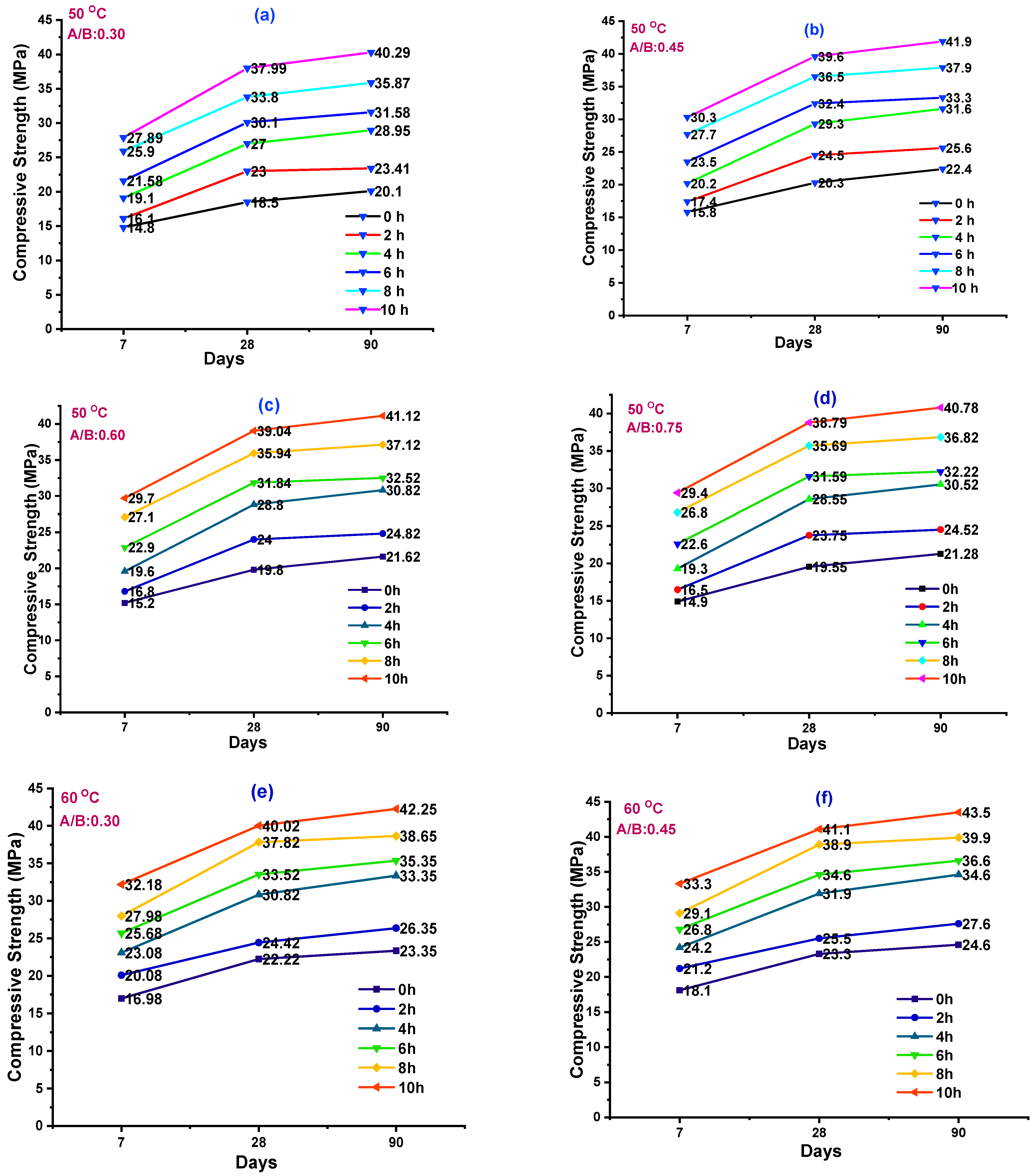
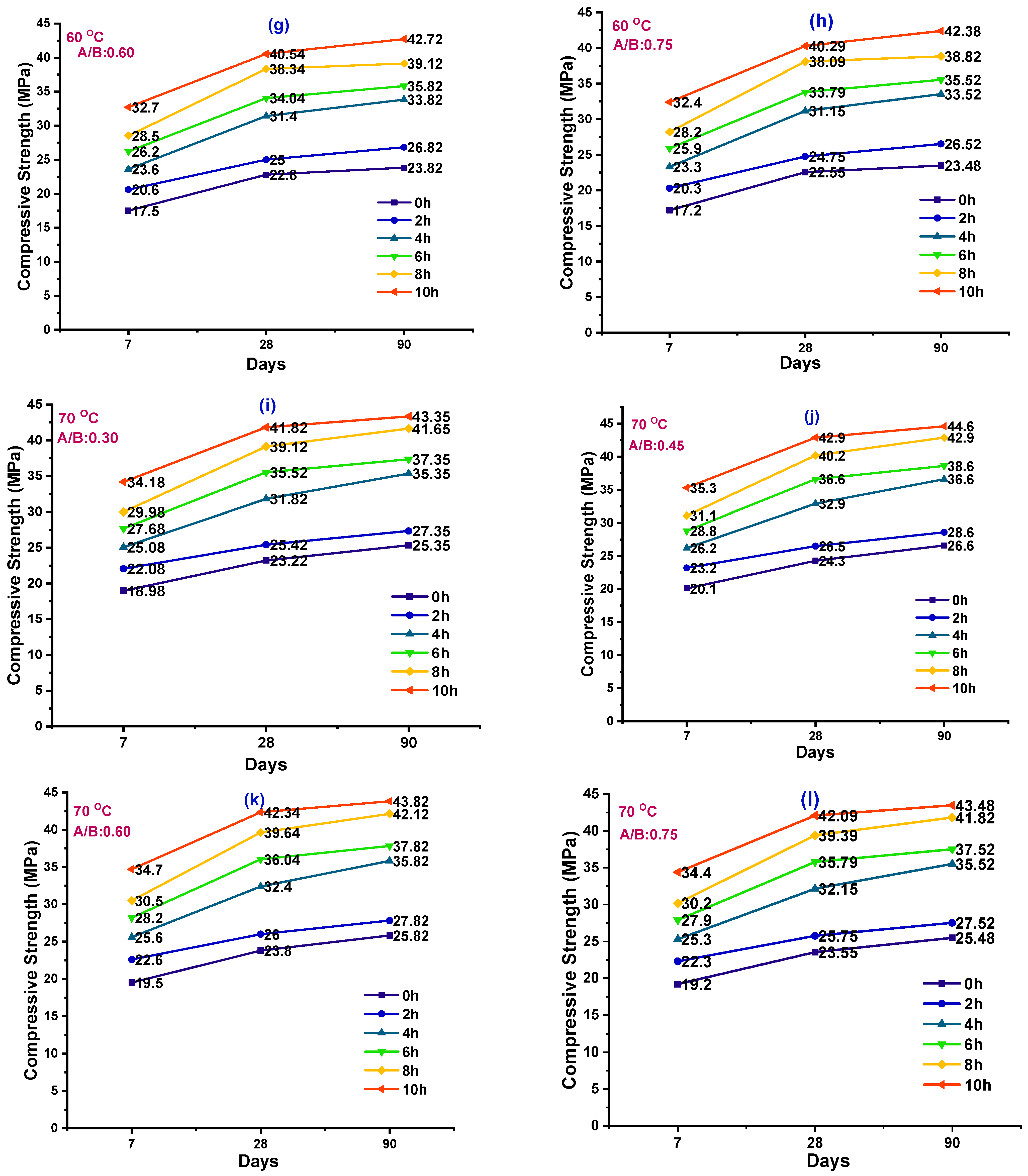
3.1.1. Effect of Temperature (50 °C) on GPC
3.1.2. Effect of Temperature (60 °C) on GPC
3.1.3. Effect of Temperature (70 °C) on GPC
3.2. Non-Destructive Testing (DNT)
4. Statistical Analysis of Tests
4.1. Probability Plot (PP)
4.2. Distribution Overview (DO) Plot
4.2.1. DO Curve for A/B:0.45
4.2.2. DO Curve for A/B:0.60
4.2.3. DO Curve for A/B:0.75
4.3. Empirical Commutative Distribution Factor (CDF)
4.4. Node CART for C1 vs. C2 to C10
5. Conclusions
- Appropriate methods need to be selected for the assessment of the strength properties of GPC. With the NDT approach, there a variation of results was observed compared with DT. For the non-destructive tests, the results showed almost 10% less compressive strength (CS) achieved compared with the destructive test.
- The probability and distribution overview shows a linear relationship between the compressive strength and an A/B ratio up to a specific point, i.e., an A/B ratio of 0.45 at 70 °C. The 7-day curve has a substantially separate distribution characteristic than the 28-day and 90-day curves, as seen by the survival and hazard function curves.
- The probability plot results in the range of 0.96–0.98, indicating that the CS results when tested at 7, 28, and 90 days vary linearly, with a 96 to 98% accuracy compared with reference mix.
Author Contributions
Funding
Institutional Review Board Statement
Informed Consent Statement
Data Availability Statement
Acknowledgments
Conflicts of Interest
Abbreviations
| A/B | Alkali/binder ratio |
| Al | Alumina |
| ASTM | American Society for Testing and Materials |
| Al2O3 | Aluminum oxide |
| CA | Calcium |
| CASH | Calcium-alumina-silica-hydrate |
| CE | Carbon emission |
| CS | Compressive strength |
| CTM | Compression testing machine |
| DCS | Destructive compressive strength |
| EE | Embodied energy |
| FA | Fly ash |
| GGBS | Ground granulated blast-furnace slag |
| GPB | Geopolymer brick |
| IS | Indian standard |
| K | Potassium |
| Kg | Kilogram |
| MPa | Mega Pascal |
| MJ | Mega Joule |
| Na | Sodium |
| Na2SiO3 | Sodium silicate |
| NaOH | Sodium hydroxide |
| NASH | Sodium-alumina-silica-hydrate |
| NDT | Non-destructive testing |
| O | Oxygen |
| RHA | Rich husk ash |
| Si | Silica |
| SiO2 | Silicon oxide |
| SiO4 | Silicon oxygen tetrahedron |
| WA | Water absorption |
| °C | Degrees Celsius |
References
- Hattaf, R.; Aboulayt, A.; Lahlou, N.; Touhami, M.O.; Gomina, M.; Samdi, A.; Moussa, R. Influence of the Integration of Geopolymer Wastes on the Characteristics of Binding Matrices Subjected to the Action of Temperature and Acid Environments. Polymers 2022, 14, 917. [Google Scholar] [CrossRef] [PubMed]
- Shill, S.K.; Al-Deen, S.; Ashraf, M.; Hutchison, W. Resistance of fly ash based geopolymer mortar to both chemicals and high thermal cycles simultaneously. Constr. Build. Mater. 2019, 239, 117886. [Google Scholar] [CrossRef]
- Shill, S.K.; Al-Deen, S.; Ashraf, M.; Garcez, E.O.; Subhani, M.; Hossain, M.M. Resistance of Geopolymer, Epoxy and Cement Mortar to Hydrocarbon-Based Synthetic Engine Lubricant, Hydraulic Fluid, Jet Fuel and Elevated Temperatures. Constr. Mater. 2022, 2, 15–26. [Google Scholar] [CrossRef]
- Wong, L.S. Durability Performance of Geopolymer Concrete: A Review. Polymers 2022, 14, 868. [Google Scholar] [CrossRef]
- Mendes, B.C.; Pedroti, L.G.; Vieira, C.M.F.; Marvilla, M.; Azevedo, A.R.; de Carvalho, J.M.F.; Ribeiro, J.C.L. Application of eco-friendly alternative activators in alkali-activated materials: A review. J. Build. Eng. 2020, 35, 102010. [Google Scholar] [CrossRef]
- Moreno-Maroto, J.M.; Delgado-Plana, P.; Cabezas-Rodríguez, R.; de Gutiérrez, R.M.; Eliche-Quesada, D.; Pérez-Villarejo, L.; Galán-Arboledas, R.J.; Bueno, S. Alkaline activation of high-crystalline low-Al2O3 Construction and Demolition Wastes to obtain geopolymers. J. Clean. Prod. 2021, 330, 129770. [Google Scholar] [CrossRef]
- Robayo-Salazar, R.; Valencia-Saavedra, W.; de Gutiérrez, R.M. Recycling of concrete, ceramic, and masonry waste via alkaline activation: Obtaining and characterization of hybrid cements. J. Build. Eng. 2021, 46, 103698. [Google Scholar] [CrossRef]
- Jayarajan, G.; Arivalagan, S. An experimental studies of geopolymer concrete incorporated with fly-ash & GGBS. Mater. Today Proc. 2021, 45, 6915–6920. [Google Scholar] [CrossRef]
- Abbass, M.; Singh, D.; Singh, G. Properties of hybrid geopolymer concrete prepared using rice husk ash, fly ash and GGBS with coconut fiber. Mater. Today Proc. 2021, 45, 4964–4970. [Google Scholar] [CrossRef]
- Ahmed, H.U.; Mohammed, A.A.; Rafiq, S.; Mohammed, A.S.; Mosavi, A.; Sor, N.H.; Qaidi, S.M.A. Compressive Strength of Sustainable Geopolymer Concrete Composites: A State-of-the-Art Review. Sustainability 2021, 13, 13502. [Google Scholar] [CrossRef]
- Saini, G.; Vattipalli, U. Assessing properties of alkali activated GGBS based self-compacting geopolymer concrete using nano-silica. Case Stud. Constr. Mater. 2020, 12, e00352. [Google Scholar] [CrossRef]
- Zeyad, A.M.; Magbool, H.M.; Tayeh, B.A.; de Azevedo, A.R.G.; Abutaleb, A.; Hussain, Q. Production of geopolymer concrete by utilizing volcanic pumice dust. Case Stud. Constr. Mater. 2022, 16, e00802. [Google Scholar] [CrossRef]
- Saint-Pierre, F.; Philibert, A.; Giroux, B.; Rivard, P. Concrete Quality Designation based on Ultrasonic Pulse Velocity. Constr. Build. Mater. 2016, 125, 1022–1027. [Google Scholar] [CrossRef]
- Lee, W.-H.; Wang, J.-H.; Ding, Y.-C.; Cheng, T.-W. A study on the characteristics and microstructures of GGBS/FA based geopolymer paste and concrete. Constr. Build. Mater. 2019, 211, 807–813. [Google Scholar] [CrossRef]
- Sýkora, M.; Diamantidis, D.; Holický, M.; Marková, J.; Rózsás, Á. Assessment of compressive strength of historic masonry using non-destructive and destructive techniques. Constr. Build. Mater. 2018, 193, 196–210. [Google Scholar] [CrossRef]
- Cavallaro, G.; Lazzara, G.; Lisuzzo, L.; Milioto, S.; Parisi, F. Filling of Mater-Bi with Nanoclays to Enhance the Biofilm Rigidity. J. Funct. Biomater. 2018, 9, 60. [Google Scholar] [CrossRef] [PubMed] [Green Version]
- Nguyen, T.A.; Guo, X.; You, F.; Saha, N.; Wu, S.; Scheuermann, A.; Ren, C.; Huang, L. Co-solidification of bauxite residue and coal ash into indurated monolith via ambient geopolymerisation for in situ environmental application. J. Hazard. Mater. 2021, 422, 126925. [Google Scholar] [CrossRef] [PubMed]
- Banchhor, S.; Murmu, M.; Deo, S.V. Combined effect of fly-ash and GGBS on performance of alkali activated concrete. J. Build. Pathol. Rehabilitation 2022, 7, 1–6. [Google Scholar] [CrossRef]
- Chen, K.; Wu, D.; Yi, M.; Cai, Q.; Zhang, Z. Mechanical and durability properties of metakaolin blended with slag geopolymer mortars used for pavement repair. Constr. Build. Mater. 2021, 281, 122566. [Google Scholar] [CrossRef]
- Rajini, B.; Rao, A.N.; Sashidhar, C. Micro-level studies of fly ash and GGBS—based geopolymer concrete using Fourier transform Infra-Red. Mater. Today Proc. 2020, 46, 586–589. [Google Scholar] [CrossRef]
- Chen, Z.; Li, J.-S.; Zhan, B.-J.; Sharma, U.; Poon, C.S. Compressive strength and microstructural properties of dry-mixed geopolymer pastes synthesized from GGBS and sewage sludge ash. Constr. Build. Mater. 2018, 182, 597–607. [Google Scholar] [CrossRef]
- Bouaissi, A.; Li, L.-Y.; Abdullah, M.M.A.B.; Bui, Q.-B. Mechanical properties and microstructure analysis of FA-GGBS-HMNS based geopolymer concrete. Constr. Build. Mater. 2019, 210, 198–209. [Google Scholar] [CrossRef]
- Islam, G.S.; Akter, S.; Reza, T.B. Sustainable high-performance, self-compacting concrete using ladle slag. Clean. Eng. Technol. 2022, 7, 100439. [Google Scholar] [CrossRef]
- Ahmed, H.U.; Mohammed, A.S.; Mohammed, A.A.; Faraj, R.H. Systematic multiscale models to predict the compressive strength of fly ash-based geopolymer concrete at various mixture proportions and curing regimes. PLoS ONE 2021, 16, e0253006. [Google Scholar] [CrossRef] [PubMed]
- Noori, A.S.; Oweed, K.M.; Raouf, R.M.; Abdulrehman, M.A. The relation between destructive and non-destructive tests of geopolymer concrete. Mater. Today Proc. 2021, 42, 2125–2133. [Google Scholar] [CrossRef]
- IS:12089-Indian Standard; Specification for Granulated Slag for the Manufacture of Portland Slag Cement. Bureau of Indian Standards: New Delhi, India, 1987.
- IS:383 Indian Standard; Specification for Coarse and Fine Aggregate from Natural Source for Concrete. Bureau of Indian Standards: New Delhi, India, 2016.
- IS:10262-Indian Standard; Concrete Mix Proportioning—Guidelines. Bureau of Indian Standards: New Delhi, India, 2019.
- IS: 1199 Indian Standard; Methods of Sampling and Analysis of Concrete. Bureau of Indian Standards: New Delhi, India, 1959.
- IS: 13311(Part 2) Indian Standard; Non-Destructive Testing of Concrete-Methods of Test. Bureau of Indian Standards: New Delhi, India, 1992.
- Shahmansouri, A.A.; Bengar, H.A.; Ghanbari, S. Compressive strength prediction of eco-efficient GGBS-based geopolymer concrete using GEP method. J. Build. Eng. 2020, 31, 101326. [Google Scholar] [CrossRef]
- Ahmed, H.U.; Mohammed, A.A.; Mohammed, A.S. The role of nanomaterials in geopolymer concrete composites: A state-of-the-art review. J. Build. Eng. 2022, 49, 104062. [Google Scholar] [CrossRef]
- Cai, J.; Pan, J.; Han, J.; Lin, Y.; Sheng, Z. Impact behaviours of engineered geopolymer composite exposed to elevated temperatures. Constr. Build. Mater. 2021, 312, 125421. [Google Scholar] [CrossRef]
- Xie, J.; Chen, W.; Wang, J.; Fang, C.; Zhang, B.; Liu, F. Coupling effects of recycled aggregate and GGBS/metakaolin on physicochemical properties of geopolymer concrete. Constr. Build. Mater. 2019, 226, 345–359. [Google Scholar] [CrossRef]
- Poornima, N.; Katyal, D.; Revathi, T.; Sivasakthi, M.; Jeyalakshmi, R. Effect of curing on mechanical strength and microstructure of fly ash blend GGBS geopolymer, Portland cement mortar and its behavior at elevated temperature. Mater. Today Proc. 2021, 47, 863–870. [Google Scholar] [CrossRef]
- Salih, M.A.; Farzadnia, N.; Demirboga, R.; Ali, A.A.A. Effect of elevated temperatures on mechanical and microstructural properties of alkali-activated mortar made up of POFA and GGBS. Constr. Build. Mater. 2022, 328, 127041. [Google Scholar] [CrossRef]
- Nagajothi, S.; Elavenil, S. Effect of GGBS Addition on Reactivity and Microstructure Properties of Ambient Cured Fly Ash Based Geopolymer Concrete. Silicon 2020, 13, 507–516. [Google Scholar] [CrossRef]
- Sousa, L.N.; Figueiredo, P.F.; França, S.; Silva, M.V.d.M.S.; Borges, P.H.R.; Bezerra, A.C.D.S. Effect of Non-Calcined Sugarcane Bagasse Ash as an Alternative Precursor on the Properties of Alkali-Activated Pastes. Molecules 2022, 27, 1185. [Google Scholar] [CrossRef]
- Kamseu, E.; Ponzoni, C.; Tippayasam, C.; Taurino, R.; Chaysuwan, D.; Sglavo, V.M.; Thavorniti, P.; Leonelli, C. Self-compacting geopolymer concretes: Effects of addition of aluminosilicate-rich fines. J. Build. Eng. 2016, 5, 211–221. [Google Scholar] [CrossRef]
- Premkumar, R.; Hariharan, P.; Rajesh, S. Effect of silica fume and recycled concrete aggregate on the mechanical properties of GGBS based geopolymer concrete. Mater. Today Proc. 2022, 60, 211–215. [Google Scholar] [CrossRef]
- Kishore, K.; Gupta, N. Mechanical characterization and assessment of composite geopolymer concrete. Mater. Today Proc. 2020, 44, 58–62. [Google Scholar] [CrossRef]
- Jagadeeswari, K.; Mohiddin, S.L.; Srinivas, K.; Vijaya, S.K. Mechanical characterization of alkali activated GGBS based geopolymer concrete. Mater. Today Proc. 2021, 64, 28–31. [Google Scholar] [CrossRef]
- Poloju, K.K.; Srinivasu, K. Impact of GGBS and strength ratio on mechanical properties of geopolymer concrete under ambient curing and oven curing. Mater. Today Proc. 2021, 42, 962–968. [Google Scholar] [CrossRef]
- Chiranjeevi, K.; Vijayalakshmi, M.M.; Praveenkumar, T.R. Investigation of fly ash and rice husk ash-based geopolymer concrete using nano particles. Appl. Nanosci. 2021, 15, 1–8. [Google Scholar] [CrossRef]
- Shilar, F.A.; Ganachari, S.V.; Patil, V.B. Investigation of the effect of granite waste powder as a binder for different molarity of geopolymer concrete on fresh and mechanical properties. Mater. Lett. 2021, 309, 131302. [Google Scholar] [CrossRef]
- Ghosh, R.; Sagar, S.P.; Kumar, A.; Gupta, S.K.; Kumar, S. Estimation of geopolymer concrete strength from ultrasonic pulse velocity (UPV) using high power pulser. J. Build. Eng. 2018, 16, 39–44. [Google Scholar] [CrossRef]
- Jindal, B.B. Investigations on the properties of geopolymer mortar and concrete with mineral admixtures: A review. Constr. Build. Mater. 2019, 227, 116644. [Google Scholar] [CrossRef]
- Marvila, M.; de Azevedo, A.; de Matos, P.; Monteiro, S.; Vieira, C. Materials for Production of High and Ultra-High Performance Concrete: Review and Perspective of Possible Novel Materials. Materials 2021, 14, 4304. [Google Scholar] [CrossRef]
- Marvila, M.; Azevedo, A.; Matos, P.; Monteiro, S.; Vieira, C. Rheological and the Fresh State Properties of Alkali-Activated Mortars by Blast Furnace Slag. Materials 2021, 14, 2069. [Google Scholar] [CrossRef]
- Hwang, S.; Yeon, J.H. Fly Ash-Added, Seawater-Mixed Pervious Concrete: Compressive Strength, Permeability, and Phosphorus Removal. Materials 2022, 15, 1407. [Google Scholar] [CrossRef] [PubMed]
- Sreenivasulu, C.; Jawahar, J.G.; Sashidhar, C. Predicting compressive strength of geopolymer concrete using NDT techniques. Asian J. Civ. Eng. 2018, 19, 513–525. [Google Scholar] [CrossRef]
- Xie, J.; Wang, J.; Rao, R.; Wang, C.; Fang, C. Effects of combined usage of GGBS and fly ash on workability and mechanical properties of alkali activated geopolymer concrete with recycled aggregate. Compos. Part B Eng. 2018, 164, 179–190. [Google Scholar] [CrossRef]
- Ju, T.; Achenbach, J.D.; Jacobs, L.; Guimaraes, M.; Qu, J. Ultrasonic nondestructive evaluation of alkali–silica reaction damage in concrete prism samples. Mater. Struct. 2017, 50, 1–13. [Google Scholar] [CrossRef]
- Ahmad, S.; Bahraq, A.A.; Shaqraa, A.A.; Khalid, H.R.; Al-Gadhib, A.H.; Maslehuddin, M. Effects of key factors on the compressive strength of metakaolin and limestone powder-based alkali-activated concrete mixtures: An experimental and statistical study. Case Stud. Constr. Mater. 2022, 16, e00915. [Google Scholar] [CrossRef]
- Mendes, B.C.; Pedroti, L.G.; Vieira, C.M.F.; Carvalho, J.M.F.; Ribeiro, J.C.L.; Albuini-Oliveira, N.M.; Andrade, I.K.R. Evaluation of eco-efficient geopolymer using chamotte and waste glass-based alkaline solutions. Case Stud. Constr. Mater. 2022, 16, e00847. [Google Scholar] [CrossRef]
- Almutairi, A.L.; Tayeh, B.A.; Adesina, A.; Isleem, H.F.; Zeyad, A.M. Potential applications of geopolymer concrete in construction: A review. Case Stud. Constr. Mater. 2021, 15, e00733. [Google Scholar] [CrossRef]
- Shilar, F.A.; Ganachari, S.V.; Patil, V.B.; Khan, T.Y.; Dawood, S. Molarity Activity Effect on Mechanical and Microstructure Properties of Geopolymer Concrete: A Review. Case Stud. Constr. Mater. 2022, 16, e01014. [Google Scholar] [CrossRef]
- Marvila, M.T.; Azevedo, A.R.G.; Delaqua, G.C.G.; Mendes, B.C.; Pedroti, L.G.; Vieira, C.M.F. Performance of geopolymer tiles in high temperature and saturation conditions. Constr. Build. Mater. 2021, 286, 122994. [Google Scholar] [CrossRef]
- Shi, X.; Zhang, C.; Wang, X.; Zhang, T.; Wang, Q. Response surface methodology for multi-objective optimization of fly ash-GGBS based geopolymer mortar. Constr. Build. Mater. 2022, 315, 125644. [Google Scholar] [CrossRef]
- Hallad, S.; Banapurmath, N.; Khan, T.; Umarfarooq, M.; Soudagar, M.; Hunashyal, A.; Gujjar, S.; Yaradoddi, J.; Ganachari, S.; Elfasakhany, A.; et al. Statistical Analysis of Polymer Nanocomposites for Mechanical Properties. Molecules 2021, 26, 4135. [Google Scholar] [CrossRef]
- Divvala, S.; Rani, M.S. Strength properties and durability studies on modified geopolymer concrete composites incorporating GGBS and metakaolin. Appl. Nanosci. 2021, 15, 1–16. [Google Scholar] [CrossRef]
- Vishnu, N.; Kolli, R.; Ravella, D.P. Studies on Self-Compacting geopolymer concrete containing flyash, GGBS, wollastonite and graphene oxide. Mater. Today Proc. 2021, 43, 2422–2427. [Google Scholar] [CrossRef]
- Wang, J.J.; Xie, J.H.; Wang, C.H.; Zhao, J.B.; Liu, F.; Fang, C. Study on the optimum initial curing condition for fly ash and GGBS based geopolymer recycled aggregate concrete. Constr. Build. Mater. 2015, 247, 118540. [Google Scholar] [CrossRef]


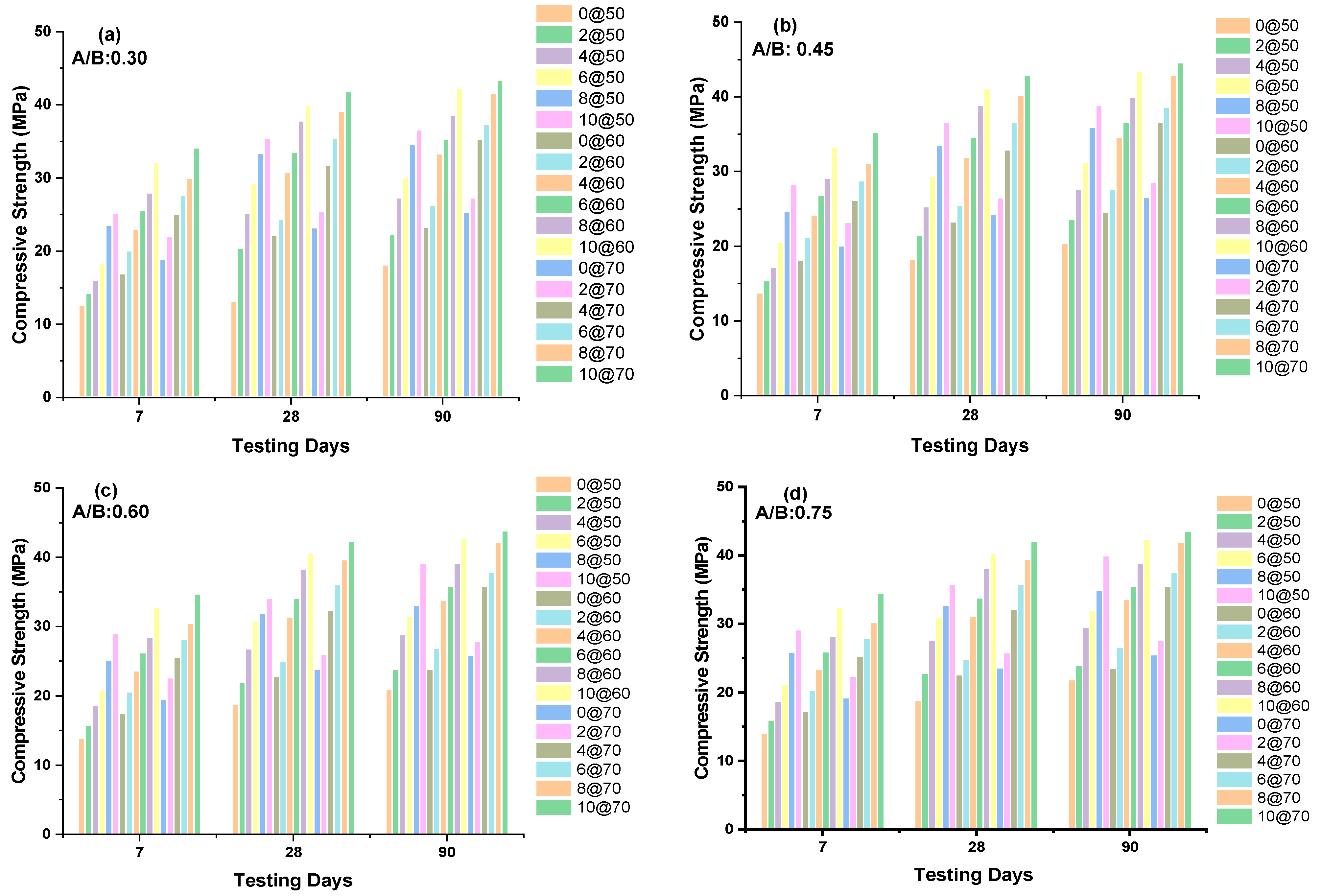
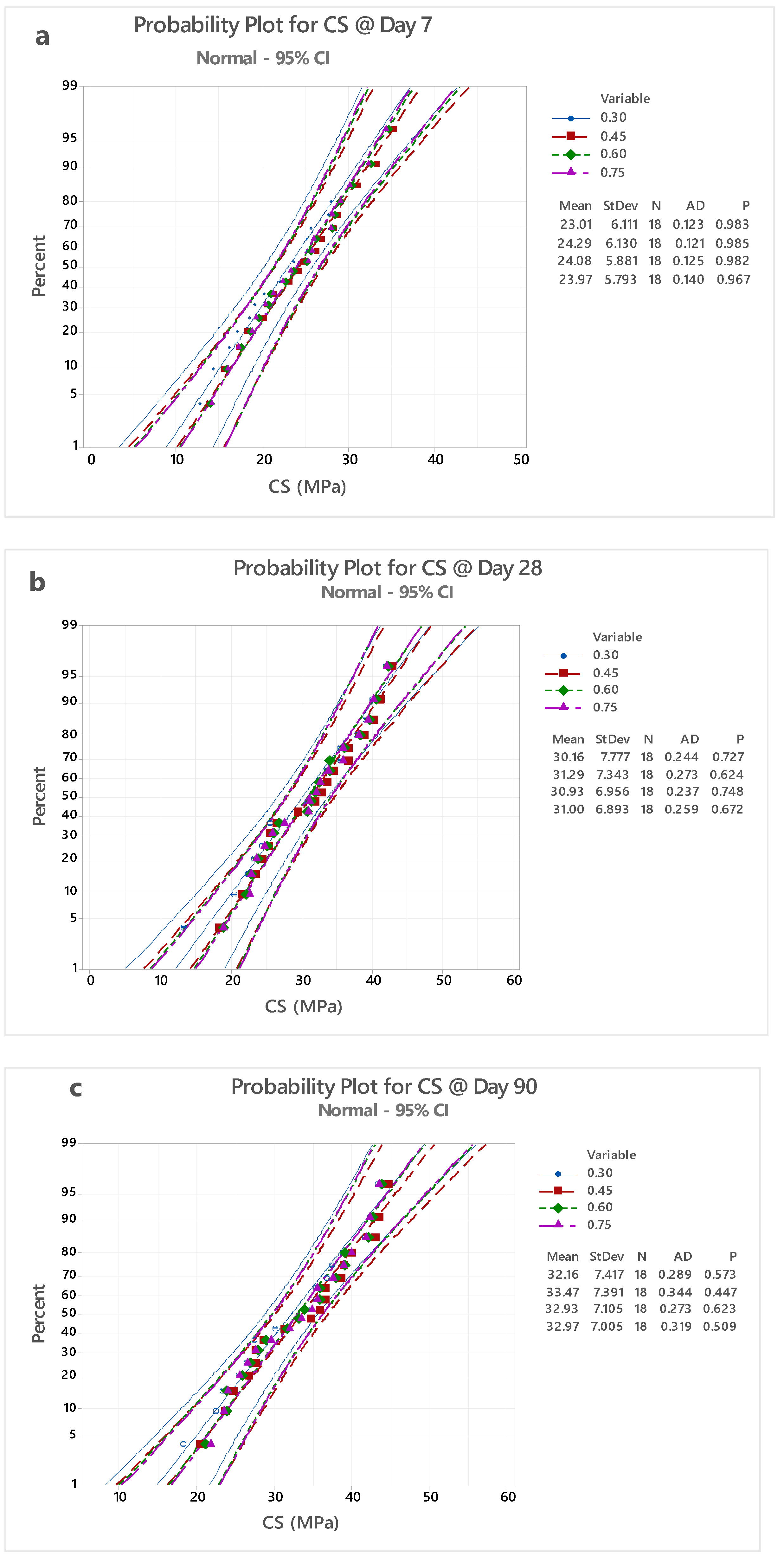
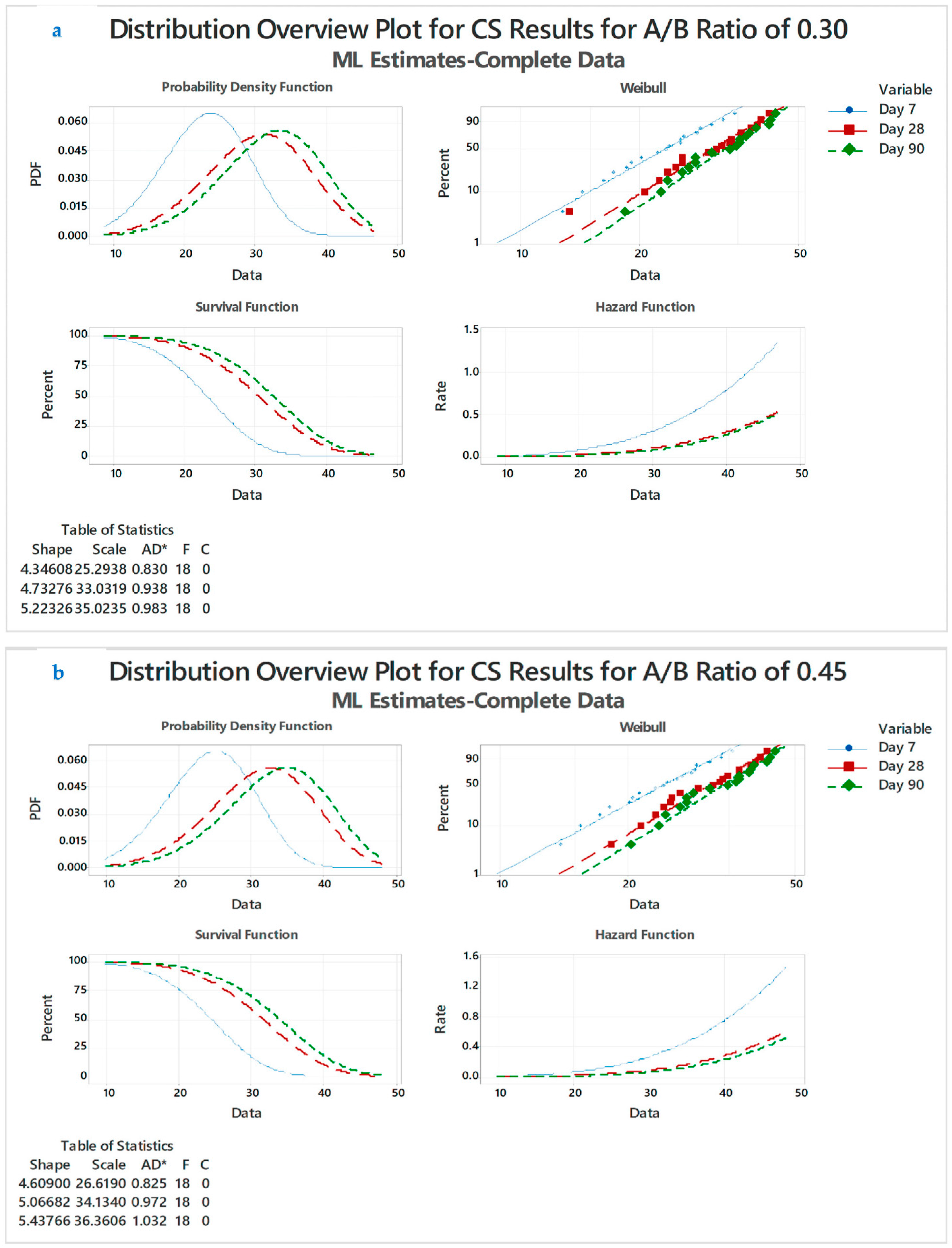
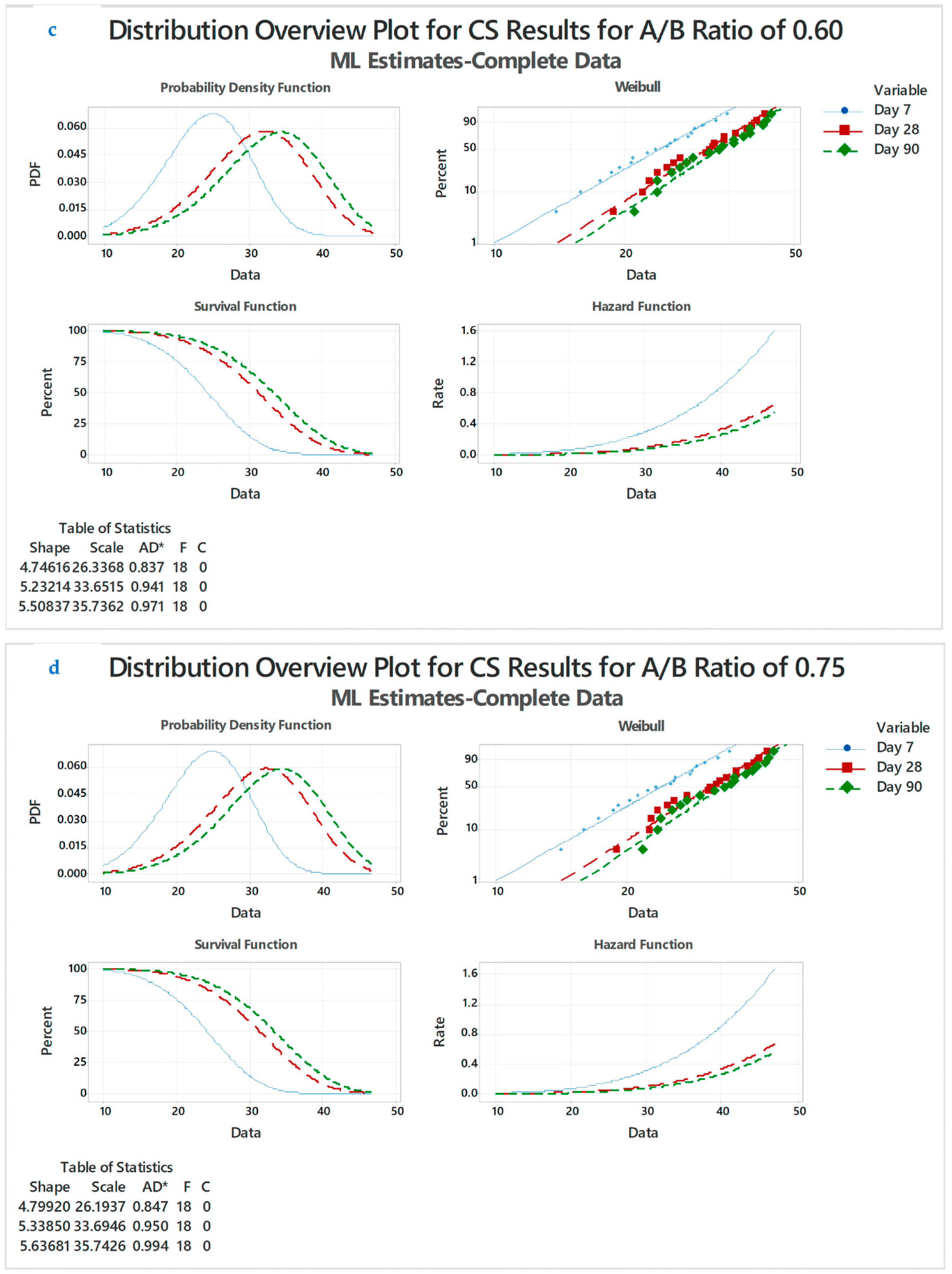
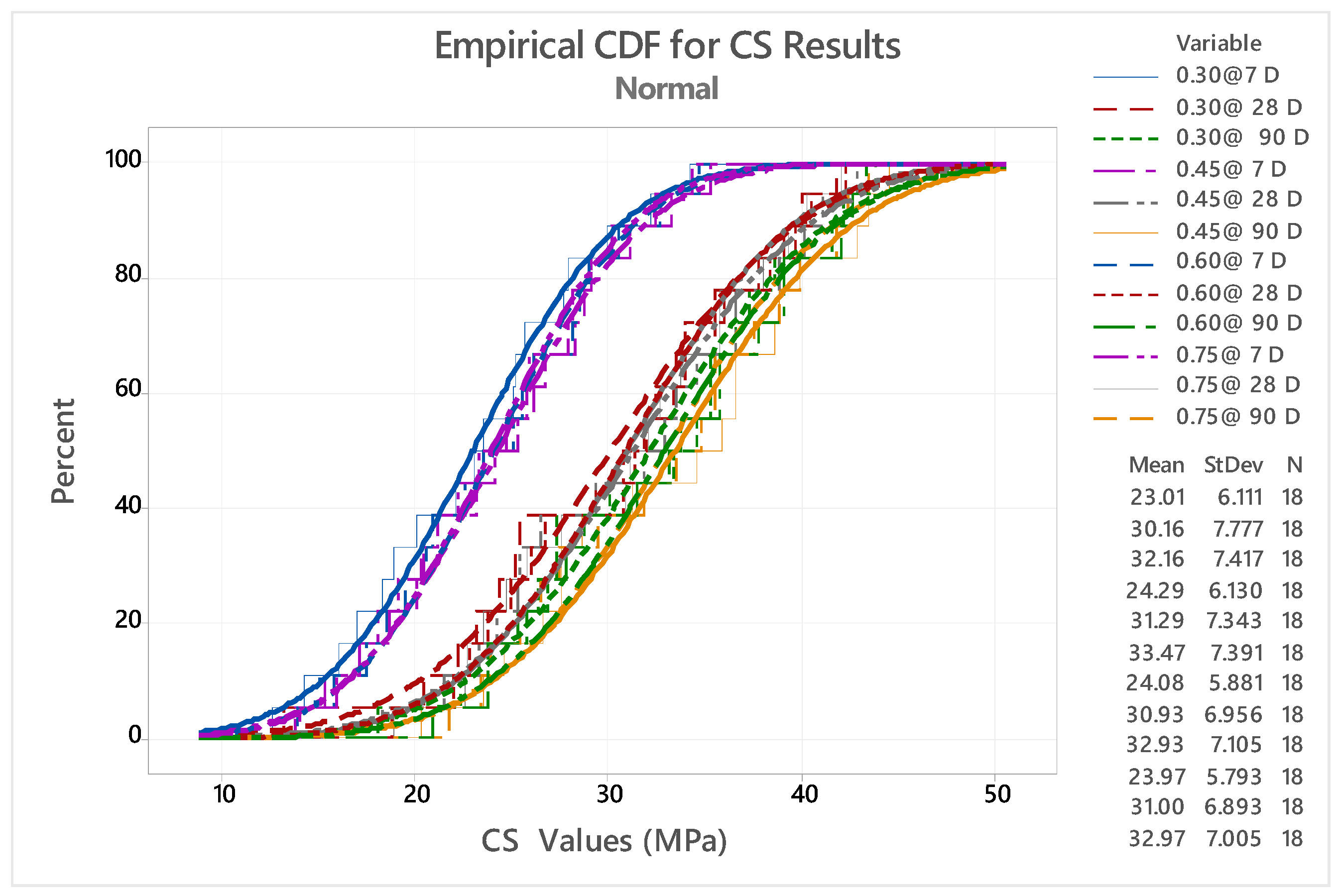
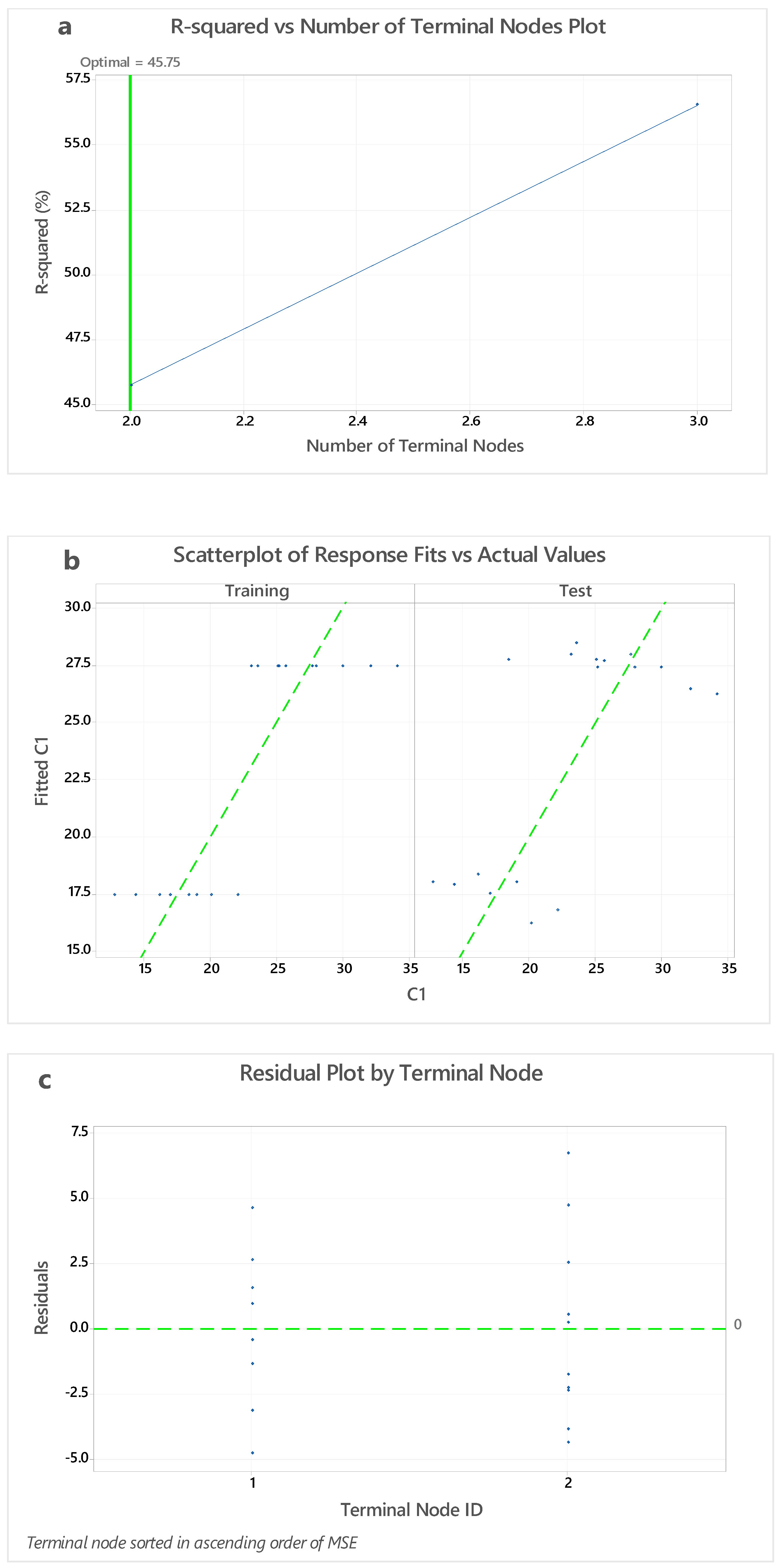
| Composition Binder | SiO2 | Al2O3 | CaO | MgO | K2O | Fe2O3 | Na2O | SO3 | Others | LOI |
|---|---|---|---|---|---|---|---|---|---|---|
| GGBS (%) | 34.80 | 15.78 | 36.81 | 7.09 | 0.44 | 0.38 | 0.27 | 2.53 | - | 1.50 |
| Materials | GGBS | Aggregate | R. Sand |
|---|---|---|---|
| Physical Properties | |||
| Specific gravity | 2.88 | 2.8 | 2.6 |
| Zone | - | - | II |
| Fineness modulus | - | 7.0 | 3.0 |
| Silt content (%) | - | - | 4 |
| Blain Air Permeability (m2/kg) | 400 | ||
| Mix ID | GGBS % | Fine Aggregate (kg/m3) | Coarse Aggregate (kg/m3) | Alkali/ Binder Ratio | Alkaline Solution | Temperature ℃ | Duration of Exposure of Temperature in Hours | |
|---|---|---|---|---|---|---|---|---|
| NaOH (kg/m3) | Na2SiO3 (kg/m3) | |||||||
| G0 | 100 | 600 | 1300 | 0.30 | 14.66 | 52.4 | 50, 60, and 70 | 0, 2, 4, 6, 8, 10 |
| G1 | 100 | 600 | 1300 | 0.30 | 14.66 | 52.4 | ||
| G2 | 100 | 600 | 1300 | 0.30 | 14.66 | 52.4 | ||
| G3 | 100 | 600 | 1300 | 0.45 | 14.66 | 52.4 | ||
| G4 | 100 | 600 | 1300 | 0.45 | 14.66 | 52.4 | ||
| G5 | 100 | 600 | 1300 | 0.45 | 14.66 | 52.4 | ||
| G6 | 100 | 600 | 1300 | 0.60 | 14.66 | 52.4 | ||
| G7 | 100 | 600 | 1300 | 0.60 | 14.66 | 52.4 | ||
| G8 | 100 | 600 | 1300 | 0.60 | 14.66 | 52.4 | ||
| G9 | 100 | 600 | 1300 | 0.75 | 14.66 | 52.4 | ||
| G10 | 100 | 600 | 1300 | 0.75 | 14.66 | 52.4 | ||
| G11 | 100 | 600 | 1300 | 0.75 | 14.66 | 52.4 | ||
| Parameters | Duration of Temperature/Hour | |||||||
|---|---|---|---|---|---|---|---|---|
| Temperature/°C | A/B Ratio | Testing/Days | 0 h | 2 h | 4 h | 6 h | 8 h | 10 h |
| Compressive Strength in/MPa | ||||||||
| 50 | 0.3 | 7 | 14.8 | 16.1 | 19.1 | 21.58 | 25.9 | 27.89 |
| 28 | 18.5 | 23 | 27 | 30.1 | 33.8 | 37.99 | ||
| 90 | 20.1 | 23.41 | 28.95 | 31.58 | 35.87 | 40.29 | ||
| 0.45 | 7 | 15.8 | 17.4 | 20.2 | 23.5 | 27.7 | 30.3 | |
| 28 | 20.3 | 24.5 | 29.3 | 32.4 | 36.5 | 39.6 | ||
| 90 | 22.4 | 25.6 | 31.6 | 33.3 | 37.9 | 41.9 | ||
| 0.6 | 7 | 15.2 | 16.8 | 19.6 | 22.9 | 27.1 | 29.7 | |
| 28 | 19.8 | 24 | 28.8 | 31.84 | 35.94 | 39.04 | ||
| 90 | 21.62 | 24.82 | 30.82 | 32.52 | 37.12 | 41.12 | ||
| 0.75 | 7 | 14.9 | 16.5 | 19.3 | 22.6 | 26.8 | 29.4 | |
| 28 | 19.55 | 23.75 | 28.55 | 31.59 | 35.69 | 38.79 | ||
| 90 | 21.28 | 24.52 | 30.52 | 32.22 | 36.82 | 40.78 | ||
| 60 | 0.3 | 7 | 16.98 | 20.08 | 23.08 | 25.68 | 27.98 | 32.18 |
| 28 | 22.22 | 24.42 | 30.82 | 33.52 | 37.82 | 40.02 | ||
| 90 | 23.35 | 26.35 | 33.35 | 35.35 | 38.65 | 42.25 | ||
| 0.45 | 7 | 18.1 | 21.2 | 24.2 | 26.8 | 29.1 | 33.3 | |
| 28 | 23.3 | 25.5 | 31.9 | 34.6 | 38.9 | 41.1 | ||
| 90 | 24.6 | 27.6 | 34.6 | 36.6 | 39.9 | 43.5 | ||
| 0.6 | 7 | 17.5 | 20.6 | 23.6 | 26.2 | 28.5 | 32.7 | |
| 28 | 22.8 | 25 | 31.4 | 34.04 | 38.34 | 40.54 | ||
| 90 | 23.82 | 26.82 | 33.82 | 35.82 | 39.12 | 42.72 | ||
| 0.75 | 7 | 17.2 | 20.3 | 23.3 | 25.9 | 28.2 | 32.4 | |
| 28 | 22.55 | 24.75 | 31.15 | 33.79 | 38.09 | 40.29 | ||
| 90 | 23.48 | 26.52 | 33.52 | 35.52 | 38.82 | 42.38 | ||
| 70 | 0.3 | 7 | 18.98 | 22.08 | 25.08 | 27.68 | 29.98 | 34.18 |
| 28 | 23.22 | 25.42 | 31.82 | 35.52 | 39.12 | 41.82 | ||
| 90 | 25.35 | 27.35 | 35.35 | 37.35 | 41.65 | 43.35 | ||
| 0.45 | 7 | 20.1 | 23.2 | 26.2 | 28.8 | 31.1 | 35.3 | |
| 28 | 24.3 | 26.5 | 32.9 | 36.6 | 40.2 | 42.9 | ||
| 90 | 26.6 | 28.6 | 36.6 | 38.6 | 42.9 | 44.6 | ||
| 0.6 | 7 | 19.5 | 22.6 | 25.6 | 28.2 | 30.5 | 34.7 | |
| 28 | 23.8 | 26 | 32.4 | 36.04 | 39.64 | 42.34 | ||
| 90 | 25.82 | 27.82 | 35.82 | 37.82 | 42.12 | 43.82 | ||
| 0.75 | 7 | 19.2 | 22.3 | 25.3 | 27.9 | 30.2 | 34.4 | |
| 28 | 23.55 | 25.75 | 32.15 | 35.79 | 39.39 | 42.09 | ||
| 90 | 25.48 | 27.52 | 35.52 | 37.52 | 41.82 | 43.48 | ||
Publisher’s Note: MDPI stays neutral with regard to jurisdictional claims in published maps and institutional affiliations. |
© 2022 by the authors. Licensee MDPI, Basel, Switzerland. This article is an open access article distributed under the terms and conditions of the Creative Commons Attribution (CC BY) license (https://creativecommons.org/licenses/by/4.0/).
Share and Cite
Shilar, F.A.; Ganachari, S.V.; Patil, V.B.; Javed, S.; Khan, T.M.Y.; Baig, R.U. Assessment of Destructive and Nondestructive Analysis for GGBS Based Geopolymer Concrete and Its Statistical Analysis. Polymers 2022, 14, 3132. https://doi.org/10.3390/polym14153132
Shilar FA, Ganachari SV, Patil VB, Javed S, Khan TMY, Baig RU. Assessment of Destructive and Nondestructive Analysis for GGBS Based Geopolymer Concrete and Its Statistical Analysis. Polymers. 2022; 14(15):3132. https://doi.org/10.3390/polym14153132
Chicago/Turabian StyleShilar, Fatheali A., Sharanabasava V. Ganachari, Veerabhadragouda B. Patil, Syed Javed, T M Yunus Khan, and Rahmath Ulla Baig. 2022. "Assessment of Destructive and Nondestructive Analysis for GGBS Based Geopolymer Concrete and Its Statistical Analysis" Polymers 14, no. 15: 3132. https://doi.org/10.3390/polym14153132
APA StyleShilar, F. A., Ganachari, S. V., Patil, V. B., Javed, S., Khan, T. M. Y., & Baig, R. U. (2022). Assessment of Destructive and Nondestructive Analysis for GGBS Based Geopolymer Concrete and Its Statistical Analysis. Polymers, 14(15), 3132. https://doi.org/10.3390/polym14153132










